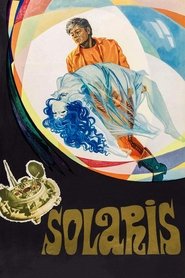[Man] is a sick god, whose ambitions exceed his powers and who does not realize it at first. A god who has created clocks, but not the time they measure. He has created systems or mechanisms that served specific ends but have now overstepped and betrayed them. And he has created eternity, which was to have measured his power, and which measures his unending defeat.
— Stanislaw Lem: Solaris (1961)
Who needs outer space when you have inner space? We need more science fiction movies by directors who are "barely interested in the exposition of what’s happening in space and instead spends [their] time languorously filming plants and water, [drifting] around an idyllic cabin filled with mementos and photographs of loved ones in order to get a sense for what it is to be human."
A simple thought experiment to explore the idea expressed by many (such as Roger Ebert) that "the second Hari is as 'real' as the first, although different." First, imagine if Kelvin was accompanied by Hari's brother when they went to Solaris station. Their separate memories of Hari will quite obviously be quite dissimilar due to knowing her in different ways: their "islands of memory" will be markedly different. The two Hari simulacrums that the planet creates for them will therefore be different. Surely the two Hari's cannot both be the 'real' Hari? But wait — her realness, her 'authenticity', is not quite the same thing as her uniqueness. (Does our concept of 'real' imply uniqueness?, etc.)
Some references:
• I think that the water plant we first see in the opening minutes is Ranunculus fluitans, the subject of an 1847 poem by William Barnes about the danger of man's interference in nature.
• The next plant that we see (the one that looks eerily like Willa's underwater hair in 1955's The Night of the Hunter) is, I think, Vallisneria spiralis.
• The tree we see later in Kris' home video that he watches with Hari is Ulmus laevis, known commonly as the Russian elm.
• Hari's dress is based on da Vinci's portrait of Ginevra de' Benci.
• When Hari and Kelvin float due to the change of gravity on the space station, the film makes a visual reference to The Three Candles (1938) by Marc Chagall.
• When Kelvin's mother holds the dog in the home video footage in the snow, it is meant to evoke da Vinci's Lady with an Ermine.
• Kelvin being reunited with his father at the end of the film alludes to Rembrandt's late work, The Return of the Prodigal Son.
• The Hunters in the Snow by Pieter Bruegel the Elder, obviously.
The implicit, disturbing question at the heart of Solaris, something relevant to our increasingly digital, increasingly parasocial world: Do we love the person, or do we love their shadow playing across the screen in our mind? Do we want to go home, or do we just want to make somewhere new look exactly like it? Surely the version of these old loves that we create is preferable to the real one. Surely the stories we tell must be more comforting than the realities of their subjects.
— Kenneth Lowe (Paste Magazine)
As the film's various photographs and video recordings suggest, the visitors are not the only ways in which memories and desires physically manifest.
— Mark Bould: BFI Film Classics: Solaris (2014)
The relationship between Kris and his dead, perfectly real wife [is] the archetypal relationship of the audience and screen at the cinema. There is photographic reality, sensual and emotional immersion, and concurrent knowledge that reality is all along an artifice, a constructed hallucination. [Like] cinema itself, she is a copy, a reproduction, an alien, a ghost.
— Steven Dillon: The Solaris Effect (2006)
[The reason we mourn is] not because we feel bad [for those who have died] but because we feel bad for ourselves. Because we can no longer be forgiven.
— Andrei Tarkovsky: Interview by Tonino Guerra
As in Siegel’s Invasion of the Body Snatchers (1956), to fall asleep is to risk a succubus’s visit. This time, however, the danger comes not from any harm she may do the hero. True horror is in having to watch someone you love destroy herself. The film that Solaris most resembles thematically is not 2001 but Hitchcock’s Vertigo (1958): the inability of the male to protect the female, the multiple disguises or “resurrections” of the loved one, the inevitability of repeating past mistakes.
— Phillip Lopate (Criterion)
Tarkovsky’s infamous disregard[ed] for narrative cohesion and exposition, frontloaded here, before the film can more naturally explore the themes addressed by its philosophically provocative storyline. Tarkovskys attitude toward these relatively petty storytelling demands is respectable only at the theoretical level. His disregard turns what should have been a cake walk into heavy baggage, and it nearly derails the proceedings.
— Rob Humanick (Slant Magazine)
In [the] relatively brief but telling [freeway] sequence, Tarkovsky stokes a generalized dread of urban dwelling through an unremarkable arrangement of images that proffers speed, sound, and movement as enemies of human consciousness, and then turns to the serenity of nature as its antidote. Solaris treats urbanization, and especially technological advancement, as a social detritus that dulls sensory experience, and in particular memory.[…]
For Tarkovsky, a pursuit of truthful representation rebukes Kubrick’s “ultimate trip” aesthetics, in which the Star Gate sequence is exemplary because it says more about the then-current state of visual effects and cinema as experience than it offers a philosophical position on space exploration and environmental preservation.
— Clayton Dillard (Slant Magazine)
Tarkovsky’s Solaris and Stalker — plundered by Hollywood since as far back as Alien and Blade Runner — were produced in the ostensibly moribund conditions of the Brezhnevite Soviet state, meaning that the USSR acted as a cultural entrepreneur for Hollywood.
— Mark Fisher: Capitalist Realism (2009)

